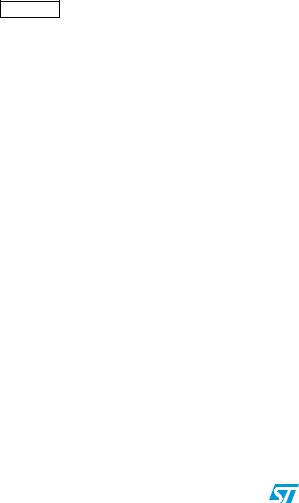
- •1 Debug system overview
- •Figure 1. Debug system block diagram
- •2 Communication layer
- •Figure 2. SWIM pin external connections
- •3 Single wire interface module (SWIM)
- •3.1 Operating modes
- •Figure 3. SWIM activation sequence
- •3.2 SWIM entry sequence
- •Figure 4. SWIM activation timing diagram
- •Figure 5. SWIM entry sequence
- •3.3 Bit format
- •3.3.1 High speed bit format
- •Figure 6. High speed bit format
- •3.3.2 Low speed bit format
- •Figure 7. Low speed bit format
- •3.4 SWIM communication protocol
- •Figure 8. Command format (Host -> Target)
- •Figure 9. Data format (Target -> Host)
- •3.5 SWIM commands
- •3.5.1 SRST: system reset
- •3.5.2 ROTF: read on the fly
- •3.5.3 WOTF: write on the fly
- •3.6 SWIM communication reset
- •3.7 CPU register access
- •3.8 SWIM communication in Halt mode
- •3.9 Physical layer
- •Figure 10. Timings on SWIM pin
- •3.10 STM8 SWIM registers
- •3.10.1 SWIM control status register (SWIM_CSR)
- •3.10.2 SWIM clock control register (CLK_SWIMCCR)
- •4 Debug module (DM)
- •4.1 Introduction
- •4.2 Main features
- •Figure 11. Debug module block diagram
- •4.3 Debug
- •4.3.1 Reset
- •4.3.2 Breakpoints
- •4.3.3 Abort
- •4.3.4 Watchdog control
- •4.3.5 Interaction with SWIM
- •4.4 Breakpoint decoding table
- •4.5 Software breakpoint mode
- •4.6 Timing description
- •Figure 12. STM8 Instruction Model
- •4.7 Abort
- •Figure 13. STM8 Debug Module Stall Timing
- •4.8 Data breakpoint
- •Figure 14. STM8 DM Data Break Timing
- •4.9 Instruction breakpoint
- •Figure 15. STM8 DM instruction break timing
- •4.10 Step mode
- •Figure 16. STM8 DM step timing
- •4.11 Application notes
- •4.11.1 Illegal Memory access
- •4.11.2 Forbidden stack access
- •4.11.3 DM break
- •4.12 DM registers
- •4.12.1 DM breakpoint register 1 extended byte (DM_BKR1E)
- •4.12.2 DM breakpoint register 1 high byte (DM_BKR1H)
- •4.12.3 DM breakpoint register 1 low byte (DM_BKR1L)
- •4.12.4 DM breakpoint register 2 extended byte (DM_BKR2E)
- •4.12.5 DM breakpoint register 2 high byte (DM_BKR2H)
- •4.12.6 DM breakpoint register 2 low byte (DM_BKR2L)
- •4.12.7 DM control register 1 (DM_CR1)
- •4.12.8 DM control register 2 (DM_CR2)
- •4.12.9 DM control/status register 1 (DM_CSR1)
- •4.12.10 DM control/status register 2 (DM_CSR2)
- •4.12.11 DM enable function register (DM_ENFCTR)
- •4.12.12 Summary of SWIM, DM and core register maps
- •Appendix A Description of the DM_ENFCTR register for each STM8 product
- •Table 6. Peripherals which are frozen by the bits of the DM_ENFCTR register for each STM8 product
- •Revision history

Single wire interface module (SWIM) |
UM0470 |
|
|
3.5SWIM commands
The Host can send a command when the line is idle or after each data byte from device. After sending the command, the host releases the line. When the SWIM is ready to answer to the command, it initiates the transfer. If a new command from the host occurs while a command is pending in SWIM, the pending command is cancelled and the new command is decoded, except in case of WOTF.
Three commands are available. They are listed in Table 1.
Table 1. |
SWIM command summary |
|
|
Command |
Binary Code |
|
|
|
|
SRST |
000 |
|
|
|
|
ROTF |
001 |
|
|
|
|
WOTF |
010 |
|
|
|
|
Reserved for future use |
011 |
|
1xx |
|
|
|
|
|
|
|
3.5.1SRST: system reset
Format: 1 command from Host to Target
SRST
Parameters:
None.
SRST command generates a system reset only if SWIM_CSR/SWIM_DM bit is set.
3.5.2ROTF: read on the fly
Format: 1 command followed by the number of bytes to be read followed by the address on three bytes.
|
ROTF |
N |
@E |
@H |
@L |
|
|
D[@] |
|
D[@+N] |
|
|
|
|
|
|
|
|
|
|
|
Parameters: |
|
|
|
|
|
|
|
|
|
|
N |
The 8 bits are the number of bytes to read (from 1 to 255) |
|
||||||||
@E/H/L: |
This is the 24-bit address to be accessed. |
|
|
|
||||||
D[...]: |
These are the data bytes read from the memory space |
|
||||||||
If the host sends a NACK to a data byte, the device will send the same byte again.
If SWIM_DM bit is cleared, ROTF can only be done on SWIM internal registers.
14/37 |
Doc ID 14024 Rev 3 |
